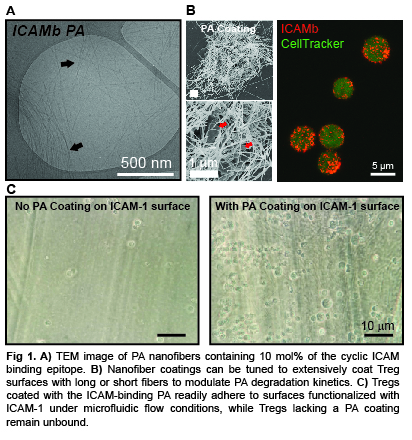Delivery of Extracellular Matrix Targeted Regulatory T Cells by Novel Nanofiber Coatings for Transplantation Therapies
1Surgery - Transplant, Northwestern University, Chicago, IL, 2Simpson Querrey Institute, Northwestern University, Chicago, IL
Meeting: 2022 American Transplant Congress
Abstract number: 384
Keywords: Adhesion molecules, Renal ischemia, T cells, Tolerance
Topic: Basic Science » Basic Science » 10 - Treg/Other Regulatory Cell/Tolerance
Session Information
Session Name: Immunoregulation and Tolerance
Session Type: Rapid Fire Oral Abstract
Date: Monday, June 6, 2022
Session Time: 5:30pm-7:00pm
 Presentation Time: 6:30pm-6:40pm
Presentation Time: 6:30pm-6:40pm
Location: Hynes Room 302
*Purpose: Regulatory CD4+CD25+FOXP3+ T cells (Tregs) have been shown to induce tolerance in transplantation models and can mitigate transplant rejection or injury following ischemic reperfusion events. For Treg therapy to be most effective for anti-inflammatory applications, infused cells need to migrate and accumulate at the transplanted organ. Therefore, targeted delivery of Tregs may enhance efficacy and reduce the number of cells required for therapeutic effect. To target inflamed or transplanted tissues, peptide amphiphile (PA) nanomaterials can present amino acid sequences that bind to locally upregulated proteins.
*Methods: We have developed a novel nanofiber technology consisting of self-assembling PA molecules that transiently coat cells and therapeutic agents. In this study, we have bioengineered PA nanofibers displaying an intercellular adhesion molecule-1 (ICAM-1) binding epitope. PA nanofibers were used to coat individual cells for their protection, targeted delivery, and to modulate biological functions. We then assessed their biological functionality in vitro using expanded Tregs. ICAM-1 is a major molecule involved in trans-endothelial migration of cells including Tregs to the inflamed/transplant site with expression primarily induced via cytokines under instances of inflammation.
*Results: The PA nanofibers were found to coat the vast majority of dispersed cells without interrupting their natural phenotype or functions. The use of a targeting bioactive peptide sequence in the PA significantly improved coated cell accumulation to inflamed or transplanted tissue sites. ICAM-binding PA coatings were internalized over the course of a few days and no PA compositions tested were toxic to cells. Only Tregs coated with ICAM-binding epitopes demonstrated targeted binding to ICAM-1 in a dynamic microfluidic flow model. Importantly, Treg phenotype and suppressive function were maintained following coating with nanofibers using in vitro co-culture assays. Finally, in vivo acute kidney injury models showed that infusion of ex vivo expanded Tregs ameliorated ischemic reperfusion injury and the nanofiber coated Tregs were detected in the injured kidneys.
*Conclusions: These results indicate that PA’s have great potential for targeted delivery of Tregs to areas of interest such as inflamed tissues and transplanted organs where they can readily function as immune regulators.
To cite this abstract in AMA style:
Gallon L, Carrow JK, He J, Sambandam Y, Lai X, Mathew J, Palmer LC, Leventhal JR, Zhang Z, Stupp SI. Delivery of Extracellular Matrix Targeted Regulatory T Cells by Novel Nanofiber Coatings for Transplantation Therapies [abstract]. Am J Transplant. 2022; 22 (suppl 3). https://atcmeetingabstracts.com/abstract/delivery-of-extracellular-matrix-targeted-regulatory-t-cells-by-novel-nanofiber-coatings-for-transplantation-therapies/. Accessed December 18, 2025.« Back to 2022 American Transplant Congress

